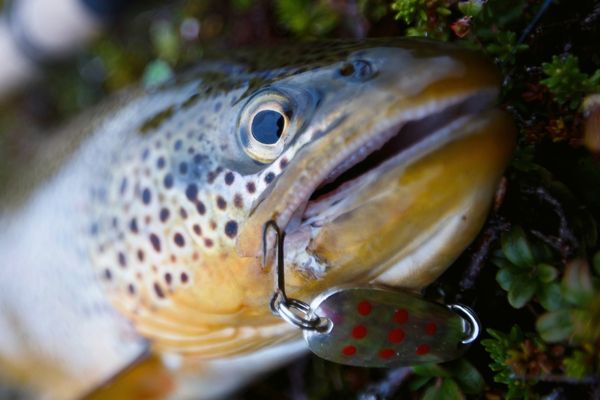Welcome to my attempt to list the 25 best trout lures of all time. Believe me when I say, narrowing down this list was no easy task. With countless lures out there designed to entice trout, it’s like picking a favorite child.
Nevertheless, I’ve managed to compile a selection of 25 lures that have proven their worth time and time again, thanks to their excellent reputations and often decades-old designs.
Before we get started, I want to emphasize that these lures are ones I personally carry in my tackle box. With just a couple of exceptions, they should be readily available no matter where you’re fishing for trout around the world.
Now, you might be wondering why I’ve mainly focused on pre-rigged hardbody and metal lures for this particular list. Well, the reason is simple: soft plastic lures deserve a class of their own, and there are just way too many of them to even attempt ranking.
Now, let’s address the elephant in the room. I understand that every angler has their personal favorite trout lures, and I respect that. In fact, there are times when even I find myself disagreeing with my own ratings!
The truth is, there’s no single lure or spinner that reigns supreme in all trout fishing situations. Factors such as location, your fishing skills, and even the trout’s mood come into play, ultimately determining which lure will shine brightest on any given day or body of water.
It’s also crucial to recognize that localization plays a significant role in lure preferences. Some lures, like the Abu Garcia Toby or the Tasmanian Devil, may dominate certain markets while being virtually unheard of in others.
That doesn’t diminish their effectiveness or their status as good lures; it simply highlights the diverse tastes and preferences of trout and anglers across different regions.
So get ready to dive into my list of the 25 best trout lures of all time. Whether you’re a seasoned angler or just starting out, I’m confident you’ll find this list both informative and entertaining. So, let’s cast our lines, reel in those trout, and discover some fantastic lures that will surely enhance your fishing experience!
1) Mepps Agilia
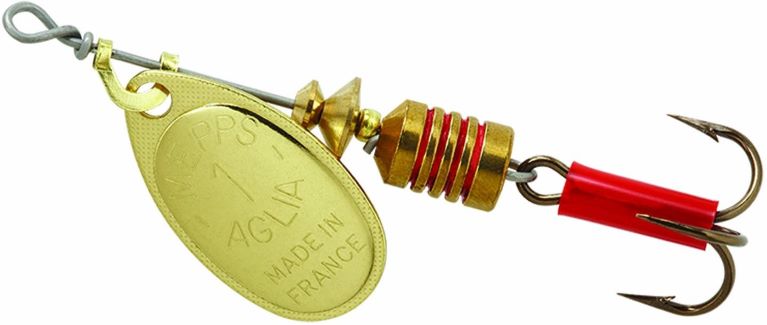
Alright, let’s kick off our list of the 25 best trout lures with a true classic: the Mepps Aglia. This inline spinner has earned a well-deserved reputation as one of the top trout lures, and it’s readily available across the globe.
When it comes to stream fishing, the Mepps Aglia really shines. Its lightweight yet durable construction makes it perfect for retrieving across ripples and through shallow holes where trout like to hang out. Trust me, this spinner knows how to grab the attention of even the smartest trout.
So why does the Mepps Aglia take the lead over other inline spinners like the Panther Martin? It’s mainly because of its strong international support. No matter where you go trout fishing, chances are you’ll find a selection of Mepps Aglia lures in the local stores.
Believe it or not, the Mepps inline spinner has been around since 1938, and it’s still deadly at catching trout. Its solid construction allows for long casts and deep runs, while its durability ensures you’ll lose more lures than damage them.
I have written a review of the Mepps Aglia over on my in-line spinner guide.
2) Panther Martin
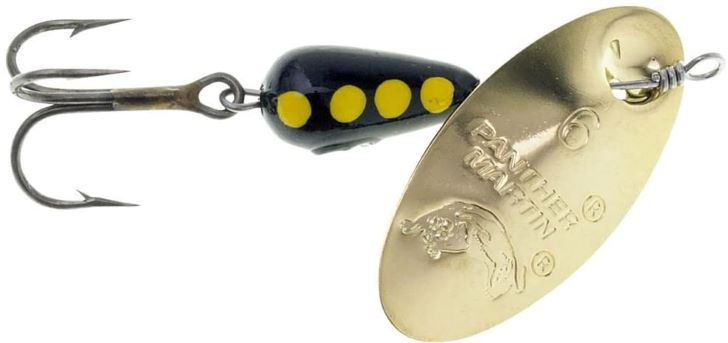
Now, let’s shift our focus to another legendary name in the world of trout fishing: the Panther Martin. With over 63 years of experience under their belt, Panther Martin has been a true pioneer in the development of in-line spinners. Alongside Mepps, they’ve made significant contributions to this lure category.
What sets the Panther Martin apart and makes it a standout choice is its larger-than-average blade. This unique feature allows the lure to work its magic even at a lower retrieval speed. So, if you find yourself tackling bigger, faster water or diving into deeper holes in search of trout, the Panther Martin is your go-to in-line spinner.
Speaking of popularity, earlier this year, I conducted an online survey to find out the most beloved trout lure among anglers. And guess what? The Panther Martin emerged as the clear winner. It’s a true classic that boasts widespread community support. In fact, it wouldn’t be a stretch to say that the Panther Martin might just be the most popular trout lure in America.
Read my full review in my in-line spinner guide.
3) Original floating Rapala

Now, let’s dive into my personal favorite trout lure: the floating Rapala. When it comes to wild brown trout, this lure has proven its worth time and time again. In fact, I’ve caught more wild brown trout on floating Rapalas than any other lure in my collection. It’s a true game-changer.
Invented back in 1936, the floating Rapala might just be the original Jerk-Bait. It paved the way for countless variations, imitations, and competitors. There’s no denying that the floating Rapala is one of the most successful and dependable trout lures ever made. Its legacy speaks for itself.
Whether you’re fishing in streams or tackling the vastness of lakes, the floating Rapala is an excellent choice for targeting wild brown trout. Its versatility knows no bounds. However, it’s worth noting that due to its lightweight construction, achieving long casts can be a bit challenging. But trust me, the results are well worth the effort. I never embark on a spin fishing adventure without a trusty floating Rapala in my tackle box.
Now, if you’re looking for a great alternative to the floating Rapala, let me introduce you to the Yo-Zuri Pins Minnow. Not only does it provide a similar fishing experience, but it also excels in the casting department. With the Yo-Zuri Pins Minnow, you can achieve even greater casting distances while still enjoying the thrill of enticing those elusive trout.
4) Hex Wobblers / Acme Kastmaster / Slices/ Ticers / wedges.

Let’s now explore a category of lures that excel in one particular aspect: long-distance casting. Within this category, numerous models make their mark, with little separating them from one another. For the purpose of this list, I’ve grouped these solid metal wedge lures together.
In North America, the Acme Kastmaster stands out as the most popular lure in this category. During the retrieve, these lures showcase a tight back-and-forth wobble that drives trout wild. The bright chrome finish emits a dazzling flash, capturing the attention of even the most elusive trout. When using these lures, a fast retrieve is often the key to success—sometimes the faster, the better. And don’t be afraid to throw in the occasional pause or jerk to add some enticing variations to your presentation.
Personally, a silver hex lure (I long ago forgot the branding) was the first lure I ever learned to fish with, and they have served me well over the years. In smaller sizes, these lures cast like a bullet, making them perfect for prospecting large bodies of water. In my tackle box, I have hexes from half a dozen manufacturers, and truth be told, I haven’t noticed much difference between them. They all get the job done.
However, it’s worth noting that the popularity of these lures has somewhat declined in recent years. Other competing lures have come to the forefront, offering more refinement and intricate details. In my home fishery, for instance, when the fish are in close proximity, inline spinners, jerkbaits, and streamers consistently outperform these solid metal bullets.
That being said, when it comes to an affordable option that can cast a mile, they can’t be beaten. Whether you’re battling a howling headwind or every yard counts in your fishing endeavors, these lures remain the top choice. Interestingly, I’ve found that most species of fish, including trout, prefer the smaller sizes.
5) Eppinger Original Dardevle
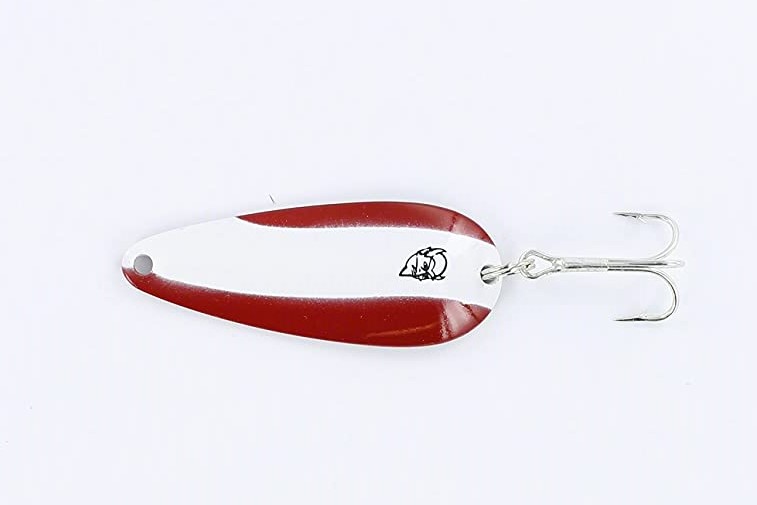
Now, let’s shine the spotlight on a lure that epitomizes the world of spoons—the Eppinger Daredevle. In fact, it might just hold the title for being the oldest lure on this list, boasting over 100 years of production.
Daredevles are versatile lures that can be cast, trolled, jigged, or even fluttered downstream. When I want to fish deep and fast, targeting trout that are holding near the bottom in those deep, rapid pools, Daredevles are my go-to choice. Here’s how I like to work them: I cast out and across the water, allowing the spoon to drift downstream, bouncing and wobbling enticingly along the way.
Now, when it comes to the retrieve, I recommend avoiding a steady, monotonous motion. Instead, try adding more movement through rod twitches and the occasional pause. It’s important to note that every spoon design responds slightly differently, so finding the ideal retrieve speed may require some trial and error. But trust me, once you discover that sweet spot, the results will be well worth the effort.
While the Eppinger Daredevle takes the crown for this category, it’s essential to mention that there are many spoon variations on the market. Unfortunately, I couldn’t include them all in this list. However, I want to highlight a few alternative spoons that are worth considering: the Thomas Colorado, Husky Devle Spoon, Len Thompson Original Series, and the Zed Spinner. Each of these spoons brings its own unique flair to the table.
6) Abu Garcia Toby
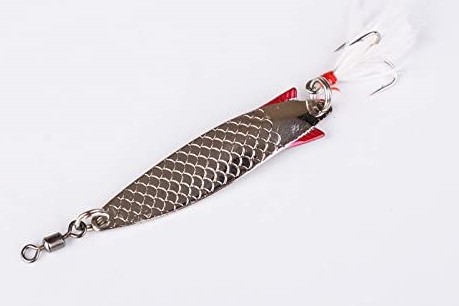
Let’s now delve into the realm of the Toby, a lure that was born in Denmark in 1956. While rarely seen in North America, the toby is among the bestselling lures globally. Designed to mimic the Tobis fish, a slim minnow, the Toby features tiny wings or fins that give it added buoyancy as it glides through the water. If you’re interested in the history of this lure, I highly recommend checking out the discussions with the inventor on realsreels.com—a great blog that delves into the story behind the Toby.
What sets the Toby apart is its construction. Each Toby lure is meticulously cut from solid brass, and only one side is painted—the concave side. This design choice is intentional and not a cost-saving measure. As the lure rotates through the water, the plain side creates a series of flashes that catch the attention of trout.
When it comes to casting, Tobys are like bullets, allowing for long and accurate casts. They are an excellent choice for prospecting from the shore or trolling at high speeds. One of the remarkable features of Tobys is their durability—they are almost indestructible, able to withstand the rigors of fishing in various conditions. Popular color options for Tobys include bronze, silver, and black/gold, each of which has its own charm and appeal.
Interestingly, the Abu Garcia Toby spawned an entire class of lures that separated them from the spoon category. In New Zealand, for example, a black and gold swiped Kilwell Turbo lure, based on the Toby, has become a favorite trout lure among anglers.
While the Toby’s popularity may have waned in recent years, particularly in North America where it has become harder to find, it remains a top pick for many trout fishermen. If you’re looking for alternatives or imitations, consider exploring options like the Thomas lures Speedy Shiner and the Kenley Toby Wever, which have gained popularity among anglers seeking similar fishing experiences.
7) Worden’s Original Rooster Tail
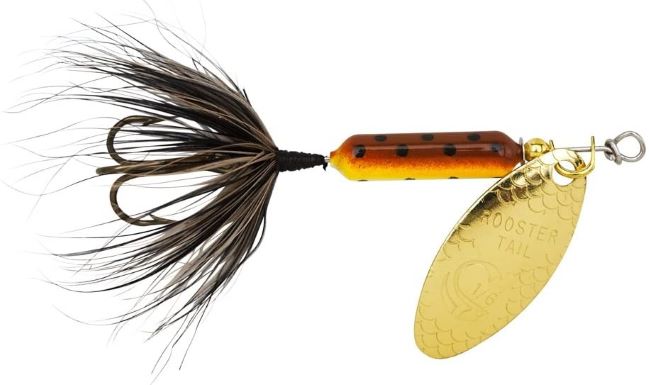
Let’s turn our attention to another remarkable inline spinner that has earned its spot on this list—the Worden’s Original Rooster Tail. Developed in the 1950s, this lure has proven its worth time and time again. Like all inline spinners, the Worden’s Original Rooster Tail is a deadly trout catcher. Its rapid spinning action, combined with the pulsating hackle, truly triggers trout to strike with ferocity.
While the Rooster Tail excels in many aspects, there is one area where it truly stands out from the crowd—fishing around structure. Thanks to its long willow leaf blade, when fished correctly, the Rooster Tail has the ability to deflect away from submerged logs and branches. Mastering the art of fishing the Rooster Tail around structure does require a certain level of skill, but in the right hands, it becomes an excellent choice for enticing trout lurking near submerged obstacles.
It’s important to note that although the Worden’s Rooster Tail finds itself lower on this list, it is by no means a lesser lure. In fact, I consider it to be just as good as any other inline spinner on the market. Each lure on this list brings its own unique qualities and strengths, and the Worden’s Rooster Tail is no exception. Its ability to attract and entice trout is a testament to its effectiveness as a fishing lure.
8) Tasmanian Devil

Let’s dive into the fascinating world of the Tasmanian Devil, a lure that was specifically designed in the 1970s to target Brown trout in the Derwent River of Tasmania. Alongside its similar counterpart, the Tillins Cobra, the Tasmanian Devil has become one of the most popular trout catchers in Australia. Its effectiveness is not limited to casting alone—it is also a deadly trolling lure.
What sets the Tasmanian Devil apart is its unique action in the water. While sinking like a slow-falling spoon, it also exhibits the wiggling movement reminiscent of a crankbait. This combination of characteristics, coupled with its relatively new design at the time, allowed the Tasmanian Devil to make a name for itself in the fishing world, even amidst established lure models. The revolutionary plastic wings attached to the lure cause it to swim erratically, darting and diving in a manner that triggers strikes from trout.
When it comes to color preferences, Australians seem to have a particular fondness for the green and gold variations of the Tasmanian Devil. This choice may be influenced by their national colors, adding a touch of patriotism to their fishing endeavors. It’s interesting to note that the main competitor to the Tasmanian Devil in Australian waters is the Tillins Cobra, another formidable trout lure.
9) Joes Fly
Let’s take a closer look at a unique lure that combines the features of an inline spinner with a fly—the Joe Fly. While it may seem unusual to drag a mayfly behind a lure, there’s no denying that trout are attracted to this combination. Personally, I have been somewhat undecided about the effectiveness of this hybrid lure, as it may not appear as natural as a traditional fly presentation. However, the trout have proven time and again that they are fond of it. For my own preference, I tend to lean towards using the Joe Fly with a trailing streamer, as it adds a touch of realism to the presentation.
One thing to note about the Joe Fly is its lightweight nature, weighing in at approximately 1/4oz (7 grams). This makes it particularly well-suited for smaller streams and lightweight fishing techniques. Its compact design and combination of inline spinner and fly elements make it a versatile option in various fishing scenarios.
10) Yakima Wordens Flatfish
The Yakima Flatfish, a classic lure that has been around for over 50 years. While it may have been overshadowed by newer flasher lures in recent times, there are still many anglers who fondly remember the effectiveness of the Flatfish.
Personally, my interest in Flatfish lures was piqued when I stumbled upon an article in an old fishing magazine that praised their virtues. Intrigued, I decided to acquire a collection of used Flatfish lures from an auction. Since then, I have been slowly working my way through the collection and experiencing the unique qualities of these lures firsthand.
One notable aspect of Flatfish lures is their erratic dance-like movement in the water. They perform best at a slow retrieval speed, making them particularly well-suited for trolling applications. The irregular movement of the Flatfish can be highly enticing to trout and other fish species, often triggering strikes.
It’s important to note that, despite their effectiveness, Flatfish lures can be challenging to cast due to their relatively lightweight nature. This makes them less suitable for prospecting open water where long-distance casting is required. However, their strengths truly shine when employed in trolling scenarios, where their distinctive action can draw in trout and entice them to bite.
11) Blue Fox Vibrax
Let’s delve into the Blue Fox Vibrax, another inline spinner that has earned its place on this list of successful trout lures. Inline spinners have proven themselves as effective trout catchers, and the Blue Fox Vibrax is no exception.
One standout feature of the Vibrax is its weight. Despite its compact size, it carries a bit of heft, allowing for longer casts and the ability to reach deeper depths compared to other inline spinners of similar size. This advantage opens up possibilities for targeting trout in various fishing scenarios, including situations where reaching distant or deeper runs is essential.
The Blue Fox Vibrax also boasts a distinctive trait that sets it apart: its ability to create loud vibrations in the water. These vibrations can prove enticing to trout, particularly those that are in an aggressive feeding mode. The combination of visual attraction and auditory stimulation makes the Vibrax a standout lure in terms of attracting trout strikes.
Notably, the Vibrax has gained popularity among anglers targeting Steelhead. This is attributed, in part, to its sinking ability. The Vibrax sinks faster compared to some other spinners, making it particularly effective in larger bodies of water where Steelhead are known to reside. Its ability to quickly reach the desired depth enhances its appeal as a go-to lure for anglers seeking Steelhead action.
I have written a longer review of the Blue Fox Vibrax over on my in-line spinner guide.
12) Storm Wildeye and Berkley Powerbait Swim Shads
Let’s explore the Storm Wildeye and Berkley Powerbait Swim Shads, two pre-rigged soft plastic lures that have earned their place on this list. While the inclusion of soft plastic baits in a list of lures sparked debates, the swim shads have distinct characteristics that make them more lure than bait, securing their spot.
These synthetic soft plastic swim shads gained immense popularity in the early 2000s. With their pre-rigged design, lifelike appearance, and affordability, they quickly became go-to options for many anglers. Companies like Storm Wildeye and Berkley Powerbait offered a range of swim shads that proved to be excellent fish catchers while being considerably more cost-effective than traditional hard body lures.
I vividly remember my own experience with swim shads. I decided to test them out near my house at a plunge pool where an irrigation canal flowed through a culvert and discharged into a settling pond. I casted a swim shad just below the outlet and was astounded by the results. In a mere fifteen minutes of fishing, I landed over 15 pounds of trout, with the largest weighing in at 4 pounds. The trout went crazy over the swim shads, and from that moment on, I became a devoted fan. Drifting swim shads through fast water became my preferred technique.
Many of these swim shads come scented, often with aniseed. However, local fishing regulations in my area prohibited the use of scented lures in spinning or fly fishing waters. Although the rangers turned a blind eye to it, technically, the scented swim shads did not meet the criteria of bait. I eventually discovered the Tsunami Pro Holographic Swim Shad, which had the desired appearance but lacked the scent. Even after the regulations relaxed, the Tsunami Pro Swim Shads remained my top choice. Personally, I doubt the scent makes much of a difference, especially when fishing in fast water.
Despite their advantages, there are a few downsides to using swim shads. Contrary to marketing claims, the plastic used in these lures is not very durable. Tails can easily be lost, and the hooks may pull out. Additionally, I’ve noticed that trout tend to swallow swim shads deeper compared to hard lures, making catch and release more challenging. Consequently, I typically reserve their use when I’m aiming to catch trout for the table.
13) Jointed Rapala
The Jointed Rapala, another timeless trout lure from the renowned brand Rapala. The Jointed Rapala stands out with its unique feature—the jointed body, which creates an exaggerated action that proves deadly when retrieved at slow speeds. This lure is particularly popular during the winter or early spring seasons.
When retrieved slowly, the Jointed Rapala springs to life, enticing trout in still or slow-moving water. The exaggerated action of the lure mimics the movements of injured or vulnerable prey, grabbing the attention of trout that take their time inspecting their potential meal before striking.
However, it’s important to be aware of a couple of downsides when using the Jointed Rapala. First, compared to regular Rapalas, they can be a bit more challenging to cast. The jointed body structure may affect the aerodynamics of the lure, making it slightly more difficult to achieve long and accurate casts.
Another potential issue with the Jointed Rapala is the risk of tangling if fished too aggressively. The jointed segments of the lure can become entangled, resulting in a less effective presentation and potentially frustrating fishing experience.
14) Rapala Countdown
The Rapala Countdown is the third Rapala lure featured on this list. The Rapala Countdown has a unique characteristic that sets it apart—it sinks at a rate of approximately one foot per second. This sinking ability makes it an excellent choice for targeting trout that are holding deeper in the water column.
When using the Countdown, you have the advantage of being able to present the lure at different depths by adjusting the length of time it remains stationary during the retrieve. Each second the lure is paused, it sinks further, allowing you to precisely target trout at specific depths.
While the floating versions of Rapala lures are great for surface or shallow presentations, there are times when trout are holding deeper and require a lure that can reach them effectively. That’s where the Rapala Countdown shines. It allows you to present the lure closer to the depth where the trout are holding, increasing your chances of enticing a strike.
Personally, I consider the Rapala Countdown to be one of my must-have lures in my tackle box. Its versatility and ability to effectively target trout at various depths make it a reliable choice in different fishing situations.
15) Acme Phoebe
The Acme Phoebe, a small spoon lure that bears resemblance to tiny fish. The unique curved design of the Phoebe allows it to be fished effectively at various speeds and depths. Whether you prefer a slow retrieve or a faster one, the Phoebe performs well and maintains its enticing action.
One of the notable characteristics of the Phoebe is its ability to run relatively close to the surface of the water. This makes it an excellent choice for fishing in shallow water, such as ripples or the shallow edges of rivers or lakes. If you’re targeting trout in these areas, the Phoebe can be a reliable lure to entice strikes.
In terms of casting, the Acme Phoebe proves to be a decent performer. Its design allows for relatively smooth and accurate casts, making it suitable for prospecting larger bodies of water. Whether you’re casting from the shore or a boat, the Phoebe can cover a good distance and help you explore different areas in your pursuit of trout.
16) Dynamic Lures HD trout
The Dynamic Lures HD trout, a relatively newer design that has gained popularity among trout anglers in recent years. This jerkbait has made a significant impact and has become one of the go-to lures for trout fishing.
The standout feature of the Dynamic Lures HD trout is its performance on a straight retrieve. When reeled in steadily, this lure exhibits a darting and wobbling action that closely mimics the movement of an injured baitfish. This realistic action can be highly effective in triggering strikes from trout, as it appeals to their predatory instincts.
The swimming depth of the HD trout is relatively close to the surface, which makes it particularly suitable for fishing in shallow streams and along river margins. In these areas, where trout often cruise and feed, the HD trout’s presentation can be enticing and provoke aggressive strikes.
Additionally, the excellent wobbling action of the HD trout on a straight retrieve makes it a great choice for trolling in shallow water. Whether you’re targeting trout in lakes or slow-moving rivers, this lure can be effective at enticing strikes from cruising fish.
Overall, the Dynamic Lures HD trout has gained popularity for a reason. Its ability to produce an injured baitfish-like action on a straight retrieve, combined with its shallow swimming depth, makes it a versatile and effective lure for trout fishing in various shallow water scenarios.
17) Thomas Buoyant
The Thomas Buoyant is a tried and tested lure that has been effectively catching trout for many years. This lure stands out from other spoon models with its unique features. One notable distinction is its slow rate of sinking, which allows for a more controlled and deliberate presentation.
The Thomas Buoyant’s rear cut-outs contribute to its distinctive action. Even at low retrieve speeds, the lure exhibits an erratic wobble that can be highly enticing to trout. This action can be particularly effective when targeting trout in shallower waters or during periods when the fish are still sluggish due to colder water temperatures.
With weights available in 1/6oz and 1/4oz, the Thomas Buoyant is well-suited for trout fishing in small streams. These sizes provide the angler with the versatility to effectively cover a variety of water depths and currents commonly found in such environments.
18) Yo-Zuri Pins Minnow
The Yo-Zuri Pins Minnow is a highly regarded jerkbait that has gained popularity among anglers. Known for its innovative design and features, the Pins Minnow stands out in the realm of jerkbaits.
The lure’s long and slender profile, in line with its name, is reminiscent of a minnow, contributing to its realistic appearance. Yo-Zuri has incorporated a durable and lifelike finish to enhance its overall appeal to trout.
One standout feature of the Pins Minnow is its ball bearing weight transfer system. This system serves multiple purposes that greatly impact the lure’s performance. Firstly, it allows the weight to shift towards the end of the lure during casting, resulting in increased casting distance—an essential aspect for anglers targeting trout. Additionally, the weight transfer system enables the lure to exhibit a wobbling and rolling action during the retrieve. These movements create vibrations that can attract trout and potentially trigger them to strike.
19) C.P. Swing
The C.P. Swing inline spinners, with their French design, have been successfully catching trout for over five decades. While they may not be as popular as they once were, their effectiveness in enticing trout remains undeniable.
The brilliance of the C.P. Swing lies in its simplicity. The spinner features a beaded body that provides weight, aiding in casting and sinking. The scaled blade attached to the spinner creates captivating reflections as it spins through the water. These reflections mimic the movements of baitfish, attracting the attention of trout.
One characteristic that sets the C.P. Swing apart from other inline spinners is its lighter weight. While this can make casting challenging, it also allows the lure to sink and flutter slowly through the water column. This slow descent can be particularly effective when targeting sluggish trout, especially during early spring when trout may be less active.
The C.P. Swing is available in classic colors, including brass, copper, and silver. The brass and copper versions retain their natural metal colors, while the silver variant features a matte coating finish. These color options have proven to be effective in enticing trout.
It’s worth noting that the fine gauge wire used in the C.P. Swing is prone to bending, which can be a consideration for anglers. However, despite this drawback, the lure’s enduring success and its ability to attract trout in various fishing conditions make it a worthwhile addition to any angler’s tackle box.
20) Luhr-Jensen Krocodile
The Luhr-Jensen Krocodile is a highly effective spoon lure that excels in distance casting. Its design combines the characteristics of a true spoon shape with a slightly thicker body, allowing for excellent casting distances. The Krocodile is known for its ability to cast far and sink quickly with an enticing flutter.
This lure is particularly effective for prospecting in larger bodies of water. Its versatility shines through as it can be retrieved slowly or manipulated with a jigging action. It’s worth noting that trout often strike the Krocodile on the drop, adding to its appeal and success rate.
The Krocodile shares some similarities with the Abu Garcia Toby lure, but it has the advantage of sinking faster. This makes it well-suited for targeting trout that are holding near the bottom, especially in deep or fast-flowing waters. The lure’s ability to reach those depths quickly and maintain its enticing action makes it a reliable choice for anglers looking to catch trout in challenging conditions.
21) Savage Gear Line Thru Seeker
The Savage Gear Line Thru Seeker is a line-through lure that has gained popularity, particularly in Nordic countries, for targeting sea trout. This lure features a long and slim tube-like design with the line running through the middle, allowing for exceptionally long casts.
One of the advantages of the Seeker is its ability to prevent trout from using the weight of the lure to dislodge the hooks. This is a significant benefit compared to traditional weighted spoons, making the Seeker a preferred choice among anglers targeting sea trout.
The design of the Seeker enables anglers to achieve greater casting distances, which can be advantageous when fishing in larger bodies of water or when trying to reach distant feeding areas. The long, slender profile of the lure may imitate the natural prey of sea trout, making it an effective choice for enticing strikes.
While the Seeker has gained popularity primarily for targeting sea trout, it may also be effective for other trout species in suitable fishing environments. Anglers who value long casts, the ability to fish at different depths, and a design that reduces the likelihood of trout throwing the lure will likely find the Savage Gear Line Thru Seeker to be a valuable addition to their fishing arsenal.
22) Super Duper
The Super Duper is a unique and popular lure known for its U-shaped design. This shape allows the lure to trap water, resulting in an erratic darting and wobbling action. While I may not have personal experience with this lure, its effectiveness and popularity among anglers speak for themselves.
The Super Duper can be fished in various ways, depending on the angler’s preference and the fishing conditions. Some fishermen choose to cast it downstream and allow it to dance around in the current, taking advantage of its unique water-trapping design. This technique can be particularly effective in enticing strikes from trout that are holding in the current.
Additionally, the Super Duper can be fished in a manner similar to traditional spoons. It can be cast, retrieved, and manipulated to mimic the movement of injured or fleeing baitfish. This versatility allows anglers to experiment with different techniques and presentations to determine what works best in their fishing location and for the targeted trout species.
While the Super Duper may have an unconventional appearance compared to other lures, its ability to generate enticing movements and vibrations in the water make it a popular choice among trout fishermen.
23) Bluefox Moresilda Trout
The Bluefox Moresilda Trout is a fantastic option for targeting sea trout, although its availability may be limited in North America. These little metal lures have a striking resemblance to tiny fish, making them highly enticing to trout. Their streamlined and dense design allows for effortless casting, soaring through the air like a bullet.
One notable feature of the Moresilda Trout is its slight curve, which imparts a subtle wobbling action during the retrieve. This natural movement can be incredibly effective in triggering strikes from trout. Additionally, this lure sinks rapidly, making it a suitable choice for fishing in deeper waters.
When fishing with the Moresilda Trout, it’s essential to maintain a fast retrieve. This technique not only keeps the lure off the bottom but also helps to avoid snags. By retrieving the lure quickly, you can imitate the movements of a fleeing baitfish, enticing trout to strike.
While I personally haven’t jigged for trout specifically with the Bluefox Moresilda Trout, lures with similar design have shown effectiveness when jigged.
24) Rebel Tracdown Minnow
The Rebel Tracdown Minnow is a versatile and effective lure for targeting trout in a variety of fishing conditions. Its unique design and enticing swimming action make it a go-to choice for many trout anglers.
The Tracdown Minnow is a sinking lure that can reach deeper water where trout often hold, especially during warmer months or in larger bodies of water. Its sinking action mimics a wounded or struggling baitfish, enticing trout to strike. The lure’s weighted body allows for accurate casts and helps it maintain a consistent depth during the retrieve.
One of the standout features of the Rebel Tracdown Minnow is its realistic appearance. It is designed to mimic the profile and swimming motion of a small minnow, which is a favored prey for trout. The lifelike finishes and color patterns further enhance its appeal, making it hard for trout to resist.
25) Devon Minnows & Trillens Ashley Spinner
Ah, the timeless classics—the Devon Minnows and Trillens Ashley Spinner. These lures hold a special place in the hearts of elderly fly fishing purists, often found, gathering dust tucked away alongside vintage in-line spinners and wooden flatfish in their tackle boxes.
It’s worth noting that the Devon Minnows and Ashley Spinner are incredibly old-school line-through lure designs, predating most other lures except for spoons. They come in two versions: floating and sinking. The floaters are meticulously crafted from wood, while the sinkers boast a sturdy brass construction.
When it comes to the sinkers, one can’t help but admire their excellent casting capabilities and fast sinking action. However, it’s important to be aware of their tendency to create a significant amount of line twist during retrieval. This line twist issue was more prominent in the past, but thanks to modern advancements in swivels and spinning reels with improved line lay, the problem has been greatly reduced. By using a high-quality superline on a reel with good line lay, you can effectively eliminate line twist concerns.
It’s fascinating to observe that even today, some anglers—primarily ones well beyong retirment age—continue to employ the Devon Minnows and Ashley Spinner to target salmon in the United Kingdom and trout in Australia. These lures have stood the test of time and continue to attract fish in certain angling circles. I don,t like them.

